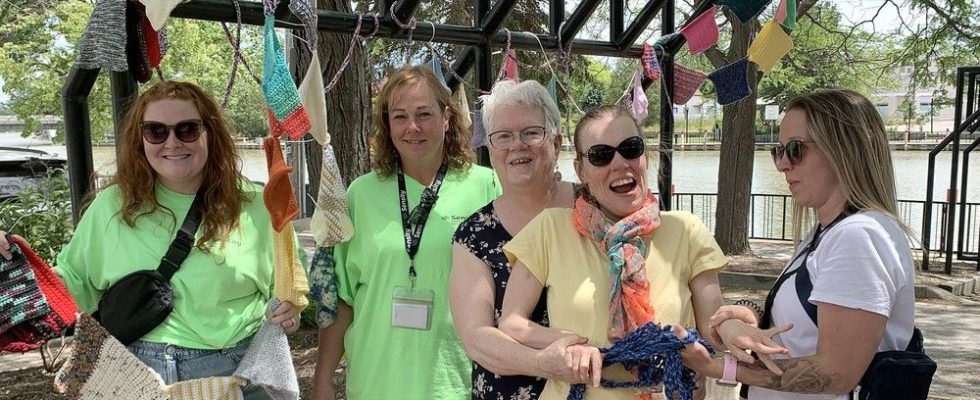WALLACEBURG – There was a yarn bombing at the Richardson Parkette this week to draw attention to people living with deafblindness.

WALLACEBURG – There was a yarn bombing at the Richardson Parkette this week to draw attention to people living with deafblindness.
While Helen Keller was arguably the most famous deafblind person in the world, Wallaceburg’s Reilly family is well acquainted with the condition.
Christa Reilly, 41, was born blind and her mother, Sandy, said they took it in stride.
But learning her daughter had the condition was a shock to the system
Noting being visually and auditorily impaired is a “very distinct disability,” Susan Reilly said when Christa was born, doctors didn’t know how many disabilities she’d have.
“When they told us she was deafblind, it was quite difficult to take in, I have to admit,” Reilly said.
“But I’ve always felt like you deal with what you’re given,” she added.
Reilly and her daughter took part in the local yarn bombing, where wool and crocheted pieces were hung and scattered around the parkette, organized by the Deafblind Sensory Support Network of Canada (Sensity) and Community Living Wallaceburg.
Yarn bombings were held across the globe Wednesday to mark Deafblind Awareness Month.
“The global theme for this year’s international campaign is connecting the world one stitch at a time,” said Samantha Gaspar communications and events co-ordinator at Sensity. “Together, Sensity and Community Living Wallaceburg are doing just that – connecting our two agencies.”
Reilly said the yarn bombing opened opportunities to start a discussion about deafblindness and what it means to be an intervener, who acts as a deafblind person’s eyes and ears.
Kim Hiltz, Sensity’s mentorship and training specialist, said when training interveners, the four areas greatly impacted by deafblindness are participation, motivation, communication and confirmation.
“The important piece is just to understand how much they miss with having that dual sensory loss,” Hiltz said. “It’s very important to keep them connected to the environment and keep them connected to the people around them just so they don’t have that isolation.”
To be deemed deafblind, there must not be enough residual vision to make up for the loss of hearing, and vice-versa.
But communication still can take place, whether through sign language, facial gestures, body movement and touch cues Hiltz said.
Wallaceburg Community Living serves three deafblind clients by providing 24-hour supports at home and in the community, said Margaret Gough, a team leader.
This involves deafblind clients exploring their home environment and doing activities in the community to have a “full sensory experience like touching things, hearing things, tasting things where it’s appropriate, so they can gather all of that information,” she said.
The goal is greater independence, said Reilly.
She said Christa does chores at home, working hand-over-hand with someone when she stirs something while baking, for example.
“So, it’s looking at a tasking and thinking, ‘What part of that task could Christa do?’ ” Reilly said.
When Christa masters that task, they look at how to add a little more to it.
“We dream big,” Reilly said. “If you don’t set your expectations high, nothing is going to happen.”

Comments
Postmedia is committed to maintaining a lively but civil forum for discussion and encourages all readers to share their views on our articles. Comments may take up to an hour for moderation before appearing on the site. We ask you to keep your comments relevant and respectful. We have enabled email notifications—you will now receive an email if you receive a reply to your comment, there is an update to a comment thread you follow or if a user you follow comments. Visit our Community Guidelines for more information and details on how to adjust your email settings.
Join the Conversation